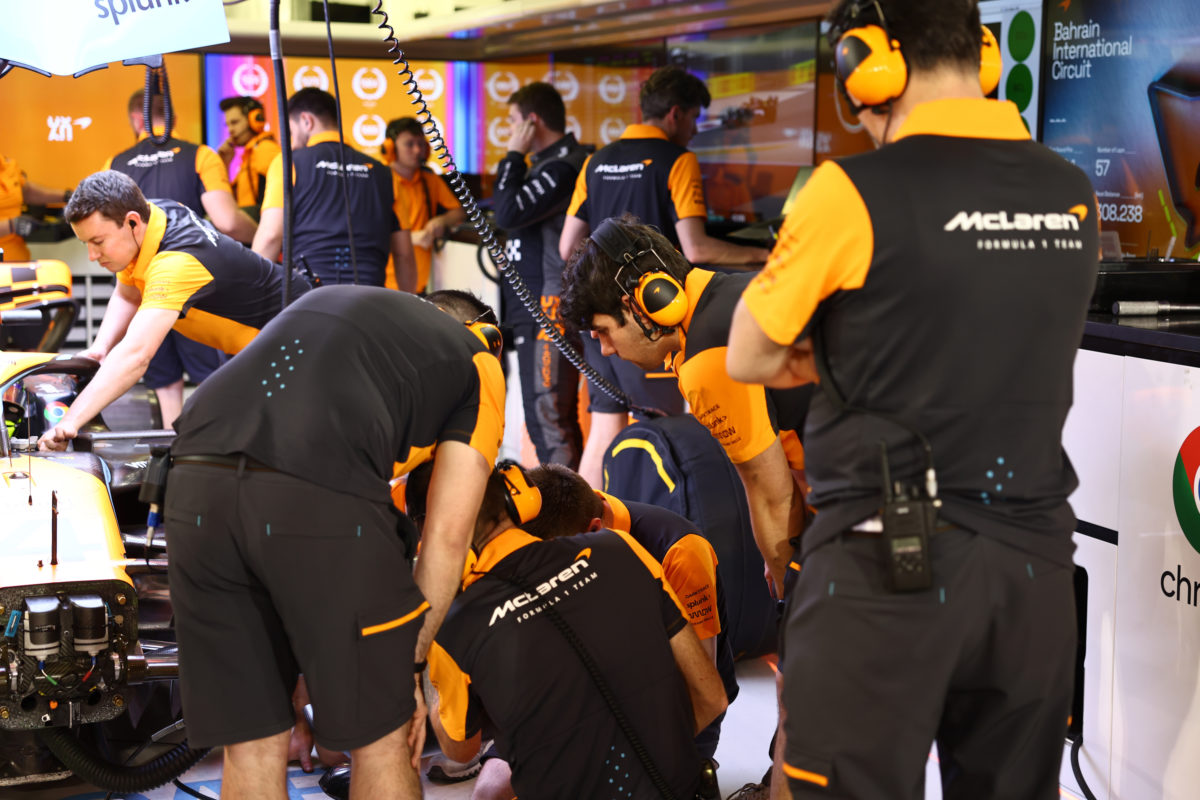
The three days of pre-season testing at the Bahrain International Circuit were about as disheartening as you could get for McLaren.
The launch of its anniversary MCL60 had already been laced with suggestions it was staring at a tough start to the year, and then came testing.
Running was continually disrupted. During pre-season last year it was brake issues. On this occasion, it was the ‘wheelbrow’ winglets over the front wheels.
The latter problem is not as concerning as the former, nevertheless, it constituted to a difficult few days in Sakhir where this weekend’s season-opening grand prix will take place.
On the final day on Saturday, Norris managed a day-low 37 laps as he was in and out of the garage, meaning McLaren was unable to gather any meaningful race pace data, or put in a representative quick lap.
Across the three days in total, Norris and new team-mate Oscar Piastri accumulated a total of 1,688 kilometres, the lowest figure of the 10 teams.
Of the 20 drivers that took to the track, only Aston Martin reserve Felipe Drugovich was behind the Woking team’s duo. The caveat, though, is he was at the wheel for two of the six half-day sessions, Norris and Piastri had three apiece.
McLaren ‘not optimistic’ for first few races
Following the launch, CEO Zak Brown offered a small degree of insight into what was behind the team’s troubles when he declared it had failed to hit its development targets.
“I think we will be going into the first race off of our projected targets,” said Brown. “(So it is) Hard to really know where that means we will be on the grid.”
The early indication is that McLaren may be staring at struggling to escape Q1. A place in the top-10 shoot-out seems a long shot as the car appears to be just over a second off the pace of Red Bull in what passed for anything close to a qualifying simulation.
Of course, you have to throw in the usual ‘sandbagging’ scenarios such as what fuel loads and engine modes were being run at any given time.
Make no mistake, though, you can sense the early deep concern inside McLaren, even if new team principal Andrea Stella attempted to put a brave face on the situation when he addressed the media at the end of the second day.
Stella said that whilst he was “not necessarily the most optimistic now” he was at least “rather more optimistic for what’s coming in the season”.
Attempting to elaborate on where the team had fallen short with its objectives, Stella said: “Last year, we had some clear objectives in terms of development.
“These were to do with aerodynamic efficiency, the exploitation of the tyres, and tyre usage, and also some other objectives to improve the balance.
“The reality is that most of these objectives have actually been met, but the objective in terms of the aerodynamic efficiency of the car, that’s the one where we are still shy of what was our target.
“It is still not where we would like it to be a top-four contender.”
McLaren months behind with development
Stella has conceded the team “realised probably late” there was a development direction it should have taken and on a path it “should have been (on) already a few months ago”.
That would appear to be seriously alarming when you consider the wrong development route adopted by Mercedes last year at the start of the new aerodynamic regulations.
The team ended up on a course that left it six to eight months behind its main rivals Red Bull and Ferrari, and even now, it still appears to be playing catch-up if its own testing data is anything to go by.
Like Mercedes, McLaren now has to be aggressive with its planned programme of upgrades if it is to realise its ambition of reclaiming the fourth place in the constructors’ championship it ceded to Alpine last year.
It is not the first time, however, McLaren has struggled with the aerodynamic efficiency of its car. Part of the blame can be apportioned to the fact it has been using an outdated wind tunnel.
That will be rectified this summer once its state-of-the-art facility, which arguably should have been available at least a year ago but for the intervention of Covid, comes online.
Even then, though, the effect of the new wind tunnel will not start to be seen until much later this year, and most certainly for the 2024 car.
Asked of Stella whether the old facilities were to blame, or whether there was a deeper conceptual issue, he replied: “The aerodynamics of a Formula 1 car is one of the most complex engineering projects on the planet.
“It’s quite challenging, it requires top facilities, expertise that you need to develop over the years.
“So I wouldn’t say there’s a specific deficit in some areas. It’s more to do with a complex variety of reasons.
“We keep mentioning the technology, the lack of the wind tunnel, and from a manpower point of view, we do have to expand the aerodynamic group. We went through a phase of contraction, and we have now changed this tendency.
“And then you have to keep building. If you look at some top teams like Red Bull, they have kept developing their expertise for a long time.
“Now they are in a condition to respond to changes of regulations, improving year by year. We have to improve in all areas, I would say.”
No B-spec but no joy early on either
There have been suggestions McLaren could have a completely different car by the time of the fourth race in Azerbaijan given the ‘spring break’ after Australia as there is now no Chinese GP.
Stella concedes the car will not necessarily be a B-spec but there will be changes that will “make a significant difference for aerodynamic efficiency”.
When the full effects of those changes will be felt remains to be seen.
For now, the feeling from Norris is one of pragmatism and a realisation the first three races at least will be a struggle, and then it is a question of what can be clawed back throughout the campaign.
“We didn’t go into the test expecting a huge amount,” said Norris.
“We know where we stand realistically, and our plan is more what we can achieve through this year rather than the car we start the year off with.
“The team are working very hard. We’d love to understand more about this car, about where it’s good and where it’s not but until we get to some more tracks I can’t answer that fully.
“Nothing’s changed too much in terms of handling and driving, so I’ll give you a better answer after the first couple of races.”
As for Piastri, you have to wonder what he is truly thinking at this present time given the furore last season over his move from Alpine.
The switch was obviously not a short-term proposition for the 21-year-old Melburnian, but he, Norris and McLaren most certainly are not going to have it easy over these first few months.




















Discussion about this post